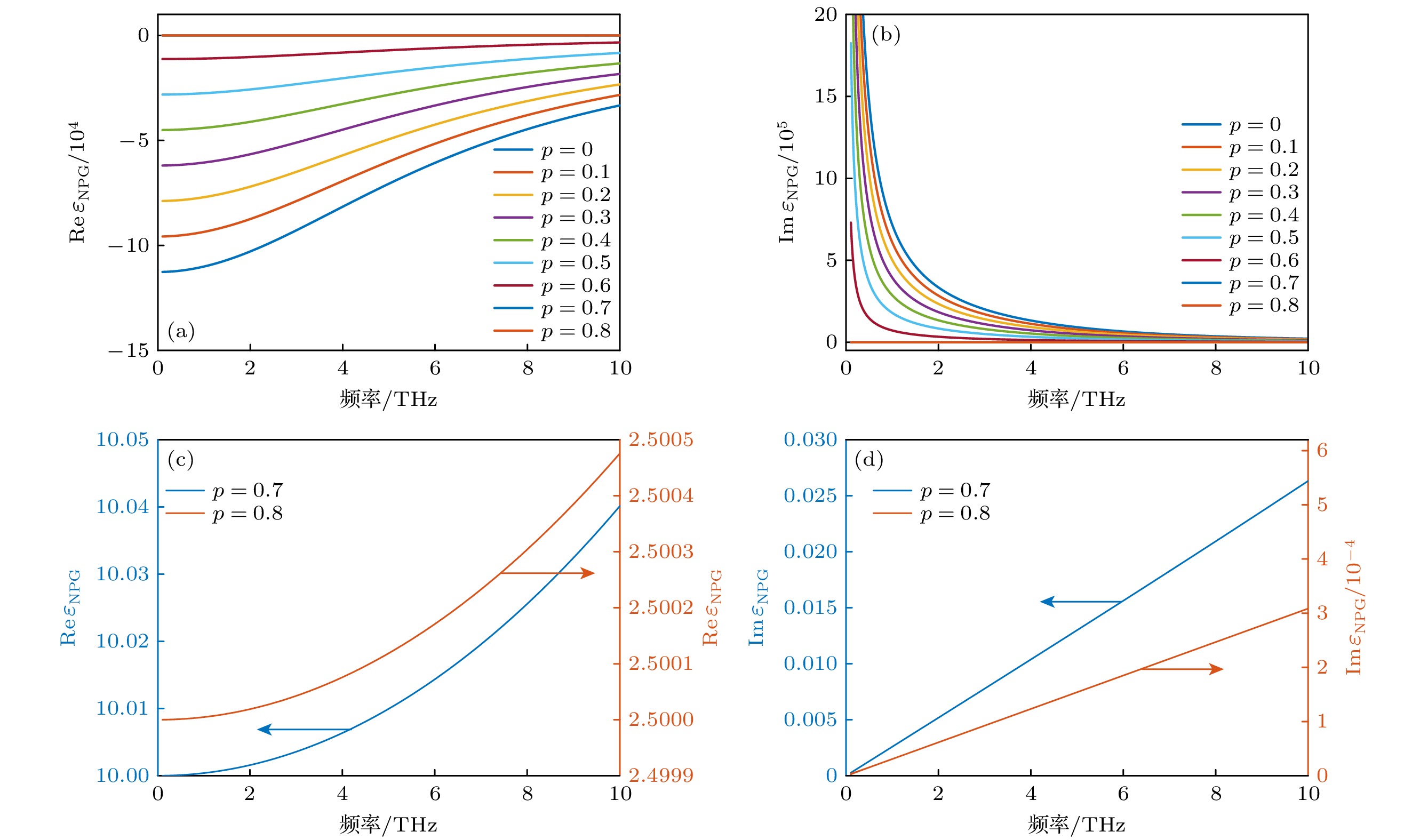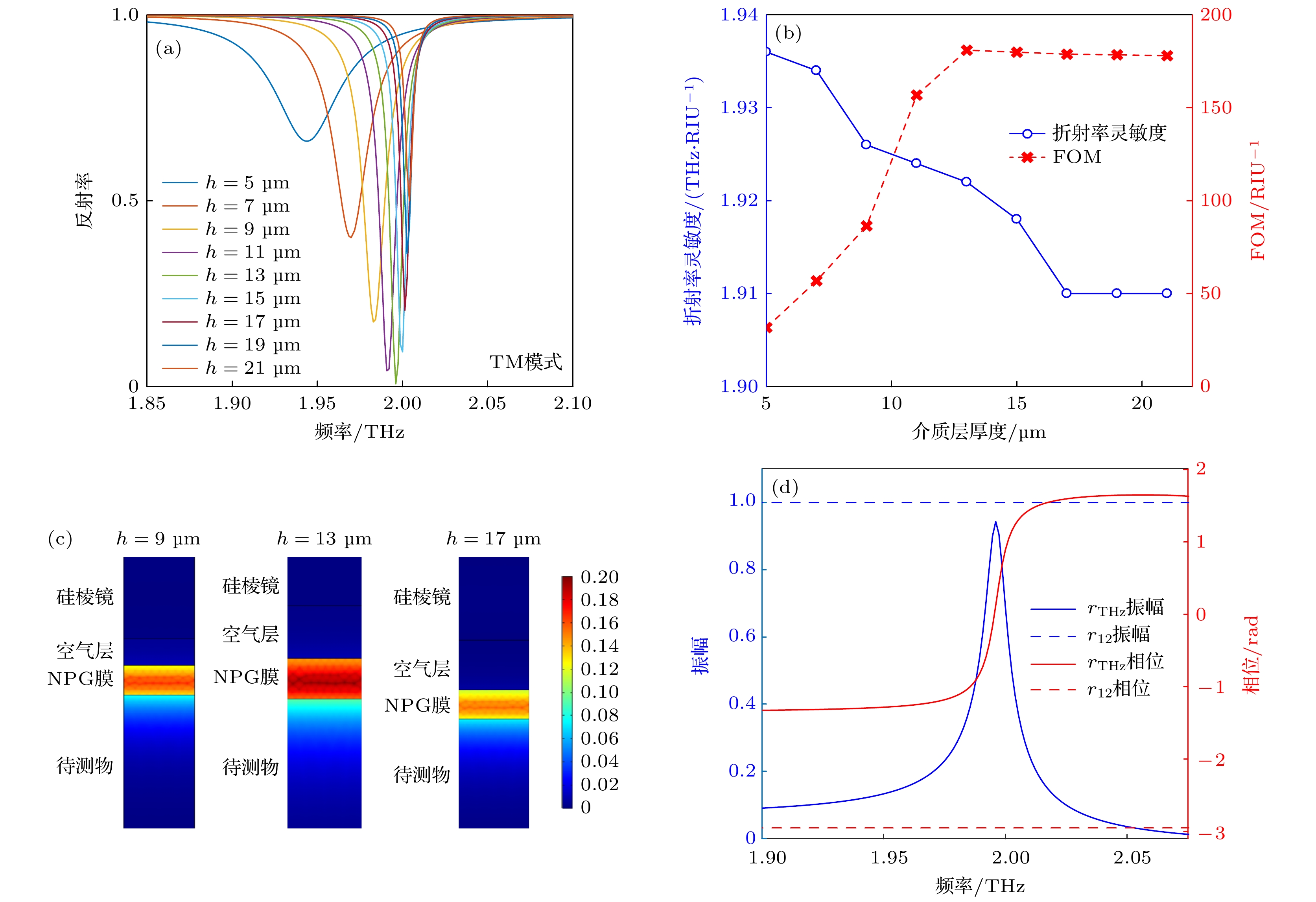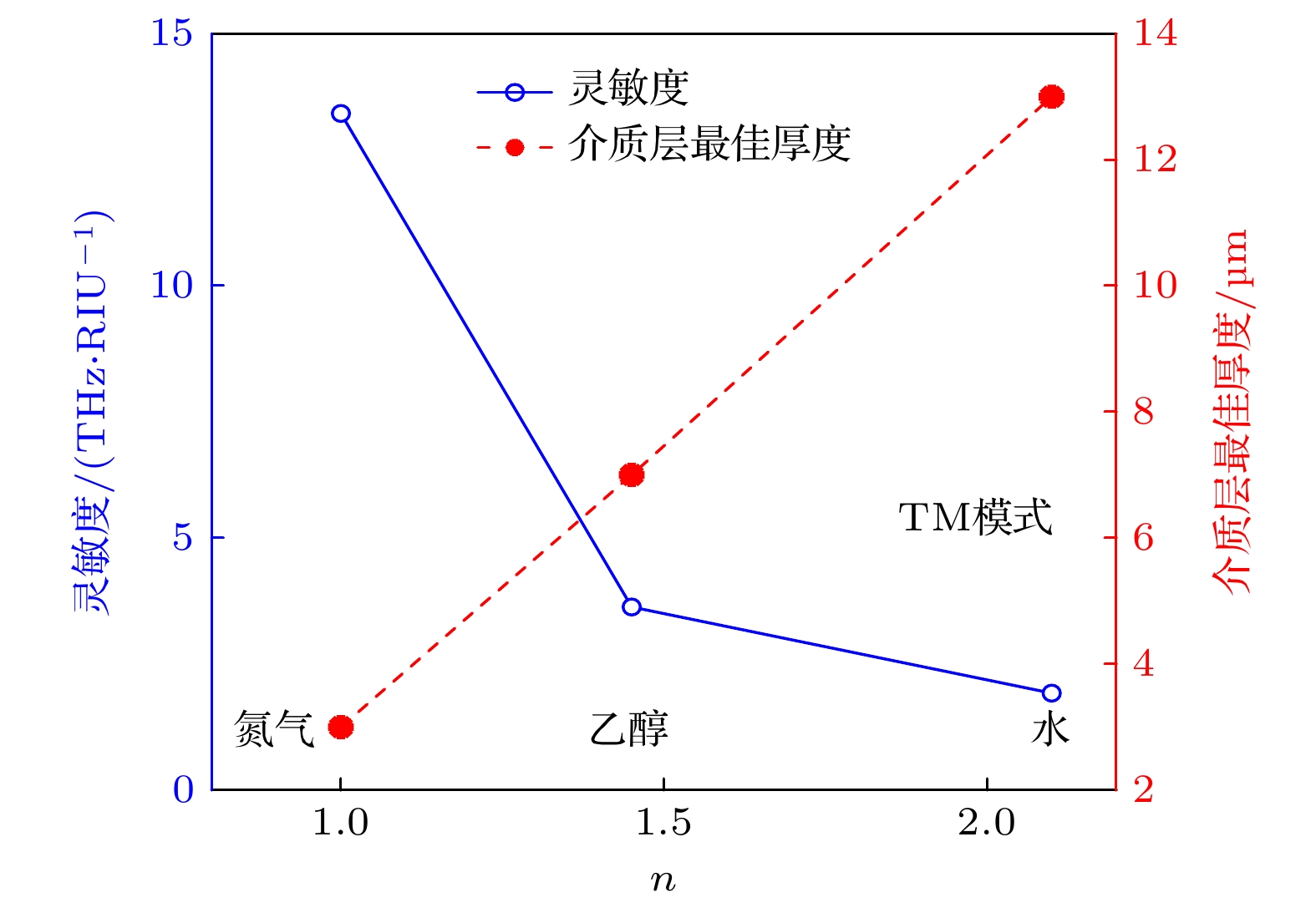-
仿真设计了一种高灵敏度太赫兹(THz)导模共振生化传感结构. 该结构由硅棱镜、介质薄膜和多孔金膜组成, 多孔金膜同时作为THz导波层和生化分子富集层, 能够增强THz导模与生化分子间的相互作用, 从而提高探测灵敏度. 当采用棱镜全反射方法激励THz横电(TE)或横磁(TM)导模后, 多孔金膜的吸收使得THz反射频谱出现尖锐的共振吸收峰, 由此可确定THz导模的共振频率及其对液体折射率和生化分子吸附量的灵敏度. 调节介质层的厚度和折射率可进一步提高上述THz传感结构的灵敏度和品质因数. 在45°入射角下的仿真结果指出, TE和TM导模的共振频率随着液体折射率或生化分子吸附量的增大而线性变化, TM导模的折射率灵敏度可高达13.42 THz/RIU, 品质因数达到167.70/RIU, TE导模对液体折射率的灵敏度小于TM导模, 但对分子吸附量的灵敏度大于TM导模, 究其原因是TE导模透出多孔金膜的消逝场比TM导模弱.A highly sensitive terahertz (THz) waveguide resonance biochemical sensor is designed and simulated. The sensor consists of a silicon prism, a dielectric layer and a nanoporous gold film. The nanoporous gold film acts as both a THz waveguiding layer and a biochemical molecular enrichment layer, which can enhance the interaction between the THz waveguide mode and the adsorbed biochemical molecules, consequently improving the sensor’s sensitivity. When the THz transverse electric (TE) or transverse magnetic (TM) modes are excited by the prism-coupling method, the THz absorption of the nanoporous gold film results in the sharp resonance dips in the THz reflection spectrum. The resonance frequencies of the THz waveguide modes and the sensitivity to either liquid refractive index (RI) or adsorbed molecules can be determined with the measured reflection spectra, and the sensor’s sensitivity and its figure of merit (FOM) can be improved by adjusting the thickness and RI of the dielectric layer. The simulation results at 45º incidence angle indicate that the resonance frequencies of the TE and TM modes of the sensor linearly change with increasing either liquid RI or the amount of adsorbed molecules, and the RI sensitivity and the FOM with the TM mode are 13.42 THz/RIU and 167.70/RIU, respectively. Compared with the TM mode, the TE mode has a lower sensitivity to lqiuid RI but a high sensitivity to adsorbed molecules. The reason for these differences is that with the TE mode the evanescent field penentrating out of the nanopous gold film is weaker than that with the TM mode.
-
Keywords:
- terahertz /
- nanoporous gold film /
- biochemical sensing /
- high sensitivity
[1] Walther M, Plochocka P, Fischer B, Helm H, Jepsen P U 2002 Biopolymers 67 310
 Google Scholar
Google Scholar
[2] He M, Azad A K, Ye S, Zhang W 2006 Opt. Commun. 259 389
 Google Scholar
Google Scholar
[3] Siegel P H 2004 IEEE Trans. Microwave Theory Tech. 52 2438
 Google Scholar
Google Scholar
[4] Jepsen P U, Cooke D G, Koch M 2011 Laser Photonics Rev. 5 124
 Google Scholar
Google Scholar
[5] Federici J F, Schulkin B, Huang F, Gary D, Barat R, Oliveira F, Zimdars D 2005 Semicond. Sci. Technol. 20 pS266
 Google Scholar
Google Scholar
[6] Zhang L, Fu Q Y, Tan Y Y, Li X M, Deng Y H, Zhou Z K, Zhou B, Xia H Q, Chen H J, Qiu C W, Zhou J H 2021 Nano Lett. 21 2681
 Google Scholar
Google Scholar
[7] Zhao Q, Zhou W J, Deng Y H, Zheng Y Q, Shi Z H, Ang L K, Zhou Z K, Wu L 2022 J. Phys. D: Appl. Phys. 55 203002
 Google Scholar
Google Scholar
[8] Otto A 1968 Z. Phys. A: Hadrons Nucl. 216 398
 Google Scholar
Google Scholar
[9] Kretschm E, Raether H 1968 Z. Naturforsch. Part A-Astrophysik Physik Und Physikalische Chemie A23 2135
 Google Scholar
Google Scholar
[10] Maier S A, Atwater H A 2005 J. Appl. Phys. 98 011101
 Google Scholar
Google Scholar
[11] Chochol J, Postava K, Cada M, Pistora J 2017 Sci. Rep. 7 13117
 Google Scholar
Google Scholar
[12] Sugimoto H, Tabata H 2020 45th International Conference on Infrared, Millimeter, and Terahertz Waves (IRMMW-THz) Electr Network, November 8–13, 2020 p1
[13] Gan C H 2012 Appl. Phys. Lett. 101 111609
 Google Scholar
Google Scholar
[14] Chen X, Lindley-Hatcher H, Stantchev R I, Wang J, Li K, Serrano A H, Taylor Z D, Castro-Camus E, Pickwell-MacPherson E 2022 Chem. Phys. Rev. 3 011311
 Google Scholar
Google Scholar
[15] Garcia-Vidal F J, Martin-Moreno L, Pendry J B 2005 J. Opt. A:Pure Appl. Opt. 7 S97
 Google Scholar
Google Scholar
[16] Pendry J B, Martin-Moreno L, Garcia-Vidal F J 2004 Science 305 847
 Google Scholar
Google Scholar
[17] Miyamaru F, Hayashi S, Otani C, Kawase K, Ogawa Y, Yoshida H, Kato E 2006 Opt. Lett. 31 1118
 Google Scholar
Google Scholar
[18] Yoshida H, Ogawa Y, Kawai Y, Hayashi S, Hayashi A, Otani C, Kato E, Miyamaru F, Kawase K 2007 Appl. Phys. Lett. 91 253901
 Google Scholar
Google Scholar
[19] Xie L J, Gao W L, Shu J, Ying Y B, Kono J C 2015 Sci. Rep. 5 8671
 Google Scholar
Google Scholar
[20] Hasebe T, Yamada Y, Tabata H 2011 Biochem. Biophys. Res. Commun. 414 192
 Google Scholar
Google Scholar
[21] Hasebe T, Kawabe S, Matsui H, Tabata H 2012 J. Appl. Phys. 112 094702
 Google Scholar
Google Scholar
[22] Tian Z, Han J G, Lu X C, Gu J Q, Xing Q R, Zhang W L 2009 Chem. Phys. Lett. 475 132
 Google Scholar
Google Scholar
[23] He M X, Li J Y, Liu G L, Han J G, Tian Z, Gu J Q, Chen T, Qin R 2013 Appl. Opt. 52 824
 Google Scholar
Google Scholar
[24] Liu G L, He M X, Tian Z, Li J Y, Liu J Z 2013 Appl Opt. 52 5695
 Google Scholar
Google Scholar
[25] Peter H, Siegel 2002 IEEE Trans. Microwave Theory Tech. 50 910
 Google Scholar
Google Scholar
[26] Ng B H, Hanham S M, Wu J F, Fernandez-Dominguez A I, Klein N, Liew Y F, Breese M B H, Hong M H, Maier S A 2014 ACS Photonics 1 1059
 Google Scholar
Google Scholar
[27] Huang Y, Zhong S, Shi T, Shen Y C, Cui D 2020 Nanophotonics 9 3011
 Google Scholar
Google Scholar
[28] O'Hara J F, Withayachumnankul W, Al-Naib I 2012 J. Infrared Millimeter Terahertz Waves 33 245
 Google Scholar
Google Scholar
[29] Saxler J, Rivas J G, Janke C, Pellemans H P M, Bolivar P H, Kurz H 2004 Phys. Rev. B 69 155427
 Google Scholar
Google Scholar
[30] Gong M, Jeon T I, Grischkowsky D 2009 Opt. Express 17 17088
 Google Scholar
Google Scholar
[31] Zhang Z, Lu D F, Qi Z M 2013 Acta Phys. Chim. Sin. 29 867
 Google Scholar
Google Scholar
[32] Qi Z M, Honma I, Zhou H 2006 Anal. Chem. 78 1034
 Google Scholar
Google Scholar
[33] Ordal M A, Long L L, Bell R J, Bell S E, Bell R R, Alexander R W, Ward C A 1983 Appl. Opt. 22 1099
 Google Scholar
Google Scholar
[34] Xu Y W, Wu Z X, Zhang L J, Lu H J, Yang P Y, Webley P A, Zhao D Y 2009 Anal. Chem. 81 503
 Google Scholar
Google Scholar
[35] Chen Q, Min L, Hammershoj P, Zhou D, Han Y, Bo W L, Yan C G, Han B H 2012 J. Am. Chem. Soc. 134 6084
 Google Scholar
Google Scholar
[36] Liu P K, Huang T J 2020 J. Infrared Millimeter Waves 39 169
[37] Ng B H, Wu J F, Hanham S M, Fernandez-Dominguez A I, Klein N, Liew Y F, Breese M B H, Hong M H, Maier S A 2013 Adv. Opt. Mater. 1 543
 Google Scholar
Google Scholar
[38] 岳伟伟, 王卫宁, 赵国忠, 张存林, 闫海涛 2005 54 3094
 Google Scholar
Google Scholar
Yue W W, Wang W N, Zhao G Z, Zhang C L, Yan H T 2005 Acta Phys. Sin. 54 3094
 Google Scholar
Google Scholar
[39] Yao H Z, Zhong S C 2014 Opt. Express 22 25149
 Google Scholar
Google Scholar
-
图 2 (a) 不同孔隙率情况下, 多孔金介电常数εNPG实部随频率的变化; (b) 不同孔隙率情况下, 多孔金介电常数εNPG虚部随频率的变化; (c) 孔隙率为0.7和0.8时, 多孔金介电常数εNPG实部随频率的变化; (d) 孔隙率为0.7和0.8时, 多孔金介电常数εNPG虚部随频率的变化
Fig. 2. (a) Variation of real part of εNPG as a function of frequency for different porosity; (b) variation of imaginary part of εNPG as a function of frequency for different porosity; (c) variation of real part of εNPG as a function of frequency for different porosity p = 0.7 and 0.8; (d) variation of imaginary part of εNPG as a function of frequency for different porosity p = 0.7 and 0.8.
图 3 TM模式下, (a) 在介质层折射率
${n_{\text{d}}} = 1$ , 厚度$h = 13{\text{ μm}}$ , 多孔金孔隙率为0.7且厚度${d_{\text{m}}} = 10{\text{ μm}}$ 时, 频率-反射率曲线及其频率-相位曲线; (b) 在介质层折射率${n_{\text{d}}} = 1$ , 厚度$h = 13{\text{ μm}}$ , 多孔金孔隙率为0.7且厚度${d_{\text{m}}} = 10{\text{ μm}}$ 时, 该结构在频率为1.996 THz情况下的电场强度二维分布Fig. 3. In TM mode: (a) Frequency-reflectivity curve and frequency-phase curve for a dielectric layer with refractive index
${n_{\text{d}}} = 1$ , thickness h = 13 μm, nanoporous gold film with porosity of 0.7 and thickness dm = 10 μm; (b) two-dimensional distribution of the electric field strength of this structure, at 1.996 THz, for a dielectric layer with refractive index${n_{\rm d}} = 1$ , thickness h = 13 μm, nanoporous gold film with porosity of 0.7 and thickness dm = 10 μm.图 4 TM模式下, 在介质层为空气(
${n_{\text{d}}} = 1$ )时, (a) 不同介质层厚度h条件下的频率-反射率曲线; (b) 不同介质层厚度h条件下折射率灵敏度和FOM的变化; (c) 三张图(自左向右)分别是介质层厚度为9, 13和17 μm情况下的能量密度时间均值(单位J/m³); (d) 当介质层折射率${n_{\text{d}}} = 1$ , 厚度$h = 13{\text{ μm}}$ 时,${r_{12}}$ 和${r_{{\text{THz}}}}$ 的振幅及其相位随频率的变化Fig. 4. In TM mode, for a dielectric layer with refractive index
${n_{\text{d}}} = 1$ , (a) frequency-reflectivity curves for different dielectric layer thicknesses h. (b) Variation of refractive index sensitivity and FOM for different dielectric layer thicknesses h. (c) The three pictures (from left to right) show the time-average energy density distribution at h = 9, 13, 17 μm, respectively. (d) The variation of the amplitudes and phases of${r_{12}}$ and${r_{{\text{THz}}}}$ with frequency for a dielectric layer with refractive index${n_{\text{d}}} = 1$ , thickness h = 13 μm图 5 TM模式下, (a) 在介质层厚度
$h = 13{\text{ μm}}$ 条件下, 介质层折射率${n_{\text{d}}}$ 不同时的频率-反射率曲线; (b) 在不同介质层折射率$ {n}_{\mathrm{d}} $ 和相应的最佳介质层厚度情况下的频率-反射率曲线; (c) 在介质层厚度$h = 13{\text{ μm}}$ , 不同介质层折射率${n_{\text{d}}}$ 条件下, 折射率灵敏度和FOM的变化及各自最佳介质层厚度情况下的FOMFig. 5. In TM mode, (a) simulated reflectivity spectra for the same dielectric layer thicknesses h = 13 μm and different dielectric layer refractive indices
${n_{\text{d}}}$ ; (b) simulated reflectivity spectra for the respective optimum dielectric layer thicknesses${h_{{\text{opt}}}}$ in different dielectric layer refractive indices${n_{\text{d}}}$ ; (c) in the case of dielectric layers with different refractive indices${n_{\text{d}}}$ , variations in refractive index sensitivity and FOM for the same thickness$h = 13{\text{ μm}}$ and for the respective optimum dielectric layer thickness${h_{{\text{opt}}}}$ , respectively.图 6 待测物为不同折射率溶液时, (a) TM模式下, 频率-反射率曲线; (b) TE模式下, 频率-反射率曲线; (c)在TM和TE模式下, 折射率-共振频率的线性拟合曲线
Fig. 6. (a) Reflectivity spectra for different refractive indexes of solutions in TM mode; (b) reflectivity spectra for different refractive indexes of solutions in TE mode; (c) refractive indexes of solutions-resonance frequency linear fitting curve for different refractive indexes of solutions in TM and TE mode.
图 8 (a) TM模式下, 在不同体积分数
$\left( {{f_{\text{c}}}} \right)$ 酪氨酸情况下的频率-反射率曲线; (b) TE模式下, 在不同体积分数$ \left( {{f_{\text{c}}}} \right) $ 酪氨酸情况下的频率-反射率曲线; (c) TM和TE情况下, 在不同体积分数$\left( {{f_{\text{c}}}} \right)$ 酪氨酸情况下, 体积分数$\left( {{f_{\text{c}}}} \right)$ 与共振频率$\left( {{f_{\text{r}}}} \right)$ 的线性拟合图Fig. 8. (a) Simulated reflectivity spectra for tyrosine in TM mode at different volume fractions
$\left( {{f_{\text{c}}}} \right)$ ; (b) simulated reflectivity spectra for tyrosine in TE mode at different volume fractions$\left( {{f_{\text{c}}}} \right)$ ; (c) volume fraction-resonance frequency linear fitting curve for tyrosine in TM and TE mode at different volume fractions$\left( {{f_{\text{c}}}} \right)$ .表 1 各类基于金膜的太赫兹传感结构尺寸和性能参数比较
Table 1. Au-based terahertz sensing structure dimensions and performance parameters.
-
[1] Walther M, Plochocka P, Fischer B, Helm H, Jepsen P U 2002 Biopolymers 67 310
 Google Scholar
Google Scholar
[2] He M, Azad A K, Ye S, Zhang W 2006 Opt. Commun. 259 389
 Google Scholar
Google Scholar
[3] Siegel P H 2004 IEEE Trans. Microwave Theory Tech. 52 2438
 Google Scholar
Google Scholar
[4] Jepsen P U, Cooke D G, Koch M 2011 Laser Photonics Rev. 5 124
 Google Scholar
Google Scholar
[5] Federici J F, Schulkin B, Huang F, Gary D, Barat R, Oliveira F, Zimdars D 2005 Semicond. Sci. Technol. 20 pS266
 Google Scholar
Google Scholar
[6] Zhang L, Fu Q Y, Tan Y Y, Li X M, Deng Y H, Zhou Z K, Zhou B, Xia H Q, Chen H J, Qiu C W, Zhou J H 2021 Nano Lett. 21 2681
 Google Scholar
Google Scholar
[7] Zhao Q, Zhou W J, Deng Y H, Zheng Y Q, Shi Z H, Ang L K, Zhou Z K, Wu L 2022 J. Phys. D: Appl. Phys. 55 203002
 Google Scholar
Google Scholar
[8] Otto A 1968 Z. Phys. A: Hadrons Nucl. 216 398
 Google Scholar
Google Scholar
[9] Kretschm E, Raether H 1968 Z. Naturforsch. Part A-Astrophysik Physik Und Physikalische Chemie A23 2135
 Google Scholar
Google Scholar
[10] Maier S A, Atwater H A 2005 J. Appl. Phys. 98 011101
 Google Scholar
Google Scholar
[11] Chochol J, Postava K, Cada M, Pistora J 2017 Sci. Rep. 7 13117
 Google Scholar
Google Scholar
[12] Sugimoto H, Tabata H 2020 45th International Conference on Infrared, Millimeter, and Terahertz Waves (IRMMW-THz) Electr Network, November 8–13, 2020 p1
[13] Gan C H 2012 Appl. Phys. Lett. 101 111609
 Google Scholar
Google Scholar
[14] Chen X, Lindley-Hatcher H, Stantchev R I, Wang J, Li K, Serrano A H, Taylor Z D, Castro-Camus E, Pickwell-MacPherson E 2022 Chem. Phys. Rev. 3 011311
 Google Scholar
Google Scholar
[15] Garcia-Vidal F J, Martin-Moreno L, Pendry J B 2005 J. Opt. A:Pure Appl. Opt. 7 S97
 Google Scholar
Google Scholar
[16] Pendry J B, Martin-Moreno L, Garcia-Vidal F J 2004 Science 305 847
 Google Scholar
Google Scholar
[17] Miyamaru F, Hayashi S, Otani C, Kawase K, Ogawa Y, Yoshida H, Kato E 2006 Opt. Lett. 31 1118
 Google Scholar
Google Scholar
[18] Yoshida H, Ogawa Y, Kawai Y, Hayashi S, Hayashi A, Otani C, Kato E, Miyamaru F, Kawase K 2007 Appl. Phys. Lett. 91 253901
 Google Scholar
Google Scholar
[19] Xie L J, Gao W L, Shu J, Ying Y B, Kono J C 2015 Sci. Rep. 5 8671
 Google Scholar
Google Scholar
[20] Hasebe T, Yamada Y, Tabata H 2011 Biochem. Biophys. Res. Commun. 414 192
 Google Scholar
Google Scholar
[21] Hasebe T, Kawabe S, Matsui H, Tabata H 2012 J. Appl. Phys. 112 094702
 Google Scholar
Google Scholar
[22] Tian Z, Han J G, Lu X C, Gu J Q, Xing Q R, Zhang W L 2009 Chem. Phys. Lett. 475 132
 Google Scholar
Google Scholar
[23] He M X, Li J Y, Liu G L, Han J G, Tian Z, Gu J Q, Chen T, Qin R 2013 Appl. Opt. 52 824
 Google Scholar
Google Scholar
[24] Liu G L, He M X, Tian Z, Li J Y, Liu J Z 2013 Appl Opt. 52 5695
 Google Scholar
Google Scholar
[25] Peter H, Siegel 2002 IEEE Trans. Microwave Theory Tech. 50 910
 Google Scholar
Google Scholar
[26] Ng B H, Hanham S M, Wu J F, Fernandez-Dominguez A I, Klein N, Liew Y F, Breese M B H, Hong M H, Maier S A 2014 ACS Photonics 1 1059
 Google Scholar
Google Scholar
[27] Huang Y, Zhong S, Shi T, Shen Y C, Cui D 2020 Nanophotonics 9 3011
 Google Scholar
Google Scholar
[28] O'Hara J F, Withayachumnankul W, Al-Naib I 2012 J. Infrared Millimeter Terahertz Waves 33 245
 Google Scholar
Google Scholar
[29] Saxler J, Rivas J G, Janke C, Pellemans H P M, Bolivar P H, Kurz H 2004 Phys. Rev. B 69 155427
 Google Scholar
Google Scholar
[30] Gong M, Jeon T I, Grischkowsky D 2009 Opt. Express 17 17088
 Google Scholar
Google Scholar
[31] Zhang Z, Lu D F, Qi Z M 2013 Acta Phys. Chim. Sin. 29 867
 Google Scholar
Google Scholar
[32] Qi Z M, Honma I, Zhou H 2006 Anal. Chem. 78 1034
 Google Scholar
Google Scholar
[33] Ordal M A, Long L L, Bell R J, Bell S E, Bell R R, Alexander R W, Ward C A 1983 Appl. Opt. 22 1099
 Google Scholar
Google Scholar
[34] Xu Y W, Wu Z X, Zhang L J, Lu H J, Yang P Y, Webley P A, Zhao D Y 2009 Anal. Chem. 81 503
 Google Scholar
Google Scholar
[35] Chen Q, Min L, Hammershoj P, Zhou D, Han Y, Bo W L, Yan C G, Han B H 2012 J. Am. Chem. Soc. 134 6084
 Google Scholar
Google Scholar
[36] Liu P K, Huang T J 2020 J. Infrared Millimeter Waves 39 169
[37] Ng B H, Wu J F, Hanham S M, Fernandez-Dominguez A I, Klein N, Liew Y F, Breese M B H, Hong M H, Maier S A 2013 Adv. Opt. Mater. 1 543
 Google Scholar
Google Scholar
[38] 岳伟伟, 王卫宁, 赵国忠, 张存林, 闫海涛 2005 54 3094
 Google Scholar
Google Scholar
Yue W W, Wang W N, Zhao G Z, Zhang C L, Yan H T 2005 Acta Phys. Sin. 54 3094
 Google Scholar
Google Scholar
[39] Yao H Z, Zhong S C 2014 Opt. Express 22 25149
 Google Scholar
Google Scholar
计量
- 文章访问数: 8031
- PDF下载量: 102
- 被引次数: 0














 下载:
下载:











































